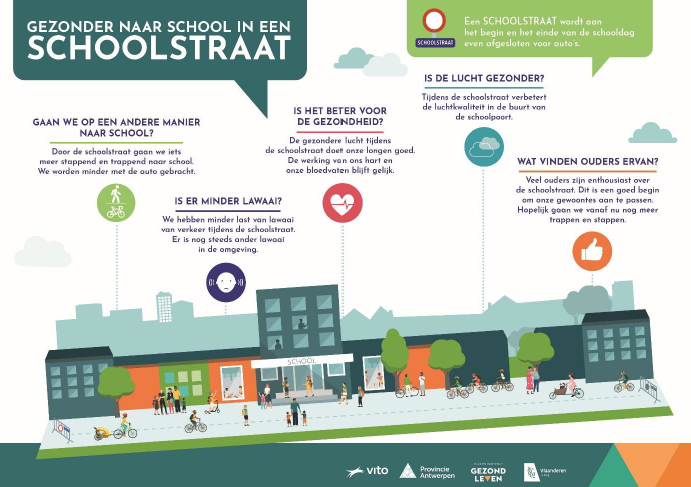A school street can contribute to a more pleasant living environment and offer health gains for children attending school, according to a study by Partner organisation Environmental Health Care (Milieugezondheidszorg). The specific school environment helps determine how much the air quality improves thanks to a school street. This makes a school street, embedded in a broader mobility plan, one of the possibilities for local authorities to focus on health via the public space.
Copyright photo: voetgangersbeweging
Intervention study into the effect of a school street
A school street is a street that is closed for motorised transport for a short period of time at the beginning and end of the school day. The aim of a school street is to break the vicious circle in which more and more parents take their child to school by car because the school environment is becoming more and more dangerous. With an intervention study, Partner organisation Environmental Health Care investigated the effect of a school street on mobility, air quality, noise, health and well-being. Partner Organisation Environmental Health Care is a research consortium of the Provincial Institute for Hygiene (PIH), Flemish research centre VITO and the Flemish Institute for Healthy Living, which is financed and monitored by the Agency for Care and Health.
The same set of measurements were carried out twice in 5 test school streets in Flanders. By comparing the measurement before the establishment of the school street with the measurement 3 weeks after the start of the school street, it was assessed whether there was a favourable effect of the school street. "Through a survey of parents and primary school children, we surveyed their choice of transport and well-being", says Karen Van de Vel of VITO, who led the research. "In the school environment, we registered the passage of cars and cyclists via pneumatic tube counters. We also monitored the concentration of NOx, black carbon (soot) and (ultra) fine particles, and the sound pressure level in the vicinity of the school. In 235 schoolchildren we investigated effects on the airways through 2 breath tests, and effects on the heart and blood vessels through a measurement of blood pressure, heart rate and thickness of the blood vessels in the retina of the eye". The tests took place between February 2019 and March 2020.
Subtle, beneficial effects on mobility, air quality, noise, health and well-being
Three weeks after the start of the school street, subtle, beneficial changes can be measured in terms of mobility, air quality, noise, health and well-being. For example, an average of 4% more children go to school by foot, with their step or bicycle under the influence of the school street. This increase in active transport increases with age. The school street has a positive effect on the air quality in the vicinity of the school gate. In schools with heavy local traffic, the improvement is more pronounced. For schools in an urban environment, the effect is more limited because the background pollution continues to play a major role. Traffic noise decreases during the period of the school street, but the general noise climate does not change. Children do experience less noise in the school environment. The health of the airways in school children improves: the value of an inflammation parameter decreases by 14%, while the elasticity of the airways improves by 10%. These figures are average values, the effect is not equally pronounced in all schools. The school street is rated positively by most parents in terms of well-being and safety. During the test phase, there was great support from parents to make the school street definitive. A parent who answered the questionnaire writes: "I can go to work with peace of mind, because I now know that my children can safely go to school by bicycle". A school street can thus break the vicious circle of traffic and insecurity around the school gate.
Tool for a Healthy Public Space
"A school street leads to health gains in various areas. So it is a way for local authorities to create a Healthy Public Space", says Annelies De Decker of the PIH. "For each school environment, the best way to make the school environment safer, more pleasant and healthier is looked at. The school street can be an interesting choice for many school environments, alongside other strategies that fit in with a healthy mobility policy. Creating a larger or long term car-free zone around schools can provide even greater health gains. In order to increase support for the measure, it is best to work together with representatives of all players (school, parents, neighbourhood, local merchants and businesses, various policy areas), and look for win-win situations".
Practical info
Consult the full report on www.zorg-en-gezondheid.be/studies-en-rapporten-gezonde-publieke-ruimte



